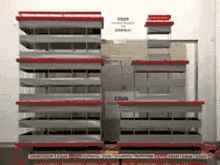| Educational level: this is a research resource. |

Building elevation control is a valuable source of vibration control of seismic loading. Thus, pyramid-shaped skyscrapers, continue to attract attention of architects and engineers because such structures promise a better stability against earthquakes and winds.
Besides, the elevation configuration can prevent buildings' resonant amplifications due to the fact that a properly configured building disperses the shear wave energy between a wide range of frequencies.
| Wikibooks has a book on the topic of Seismic fitness. |
Earthquake or wind quieting ability of the elevation configuration is provided by a specific pattern of multiple reflections and transmissions of vertically propagating shear waves, which are generated by breakdowns into homogeneity of story layers, and a taper. Any abrupt changes of the propagating waves velocity result in a considerable dispersion of the wave energy between a wide ranges of frequencies thus preventing the resonant displacement amplifications in the building.
Tapered profile of a building is not a compulsory feature of this method of structural control. A similar resonance preventing effect can be also obtained by a proper tapering of other characteristics of a building structure, namely, its mass and stiffness . As a result, the building elevation configuration techniques permit an architectural design that may be both attractive and functional.

